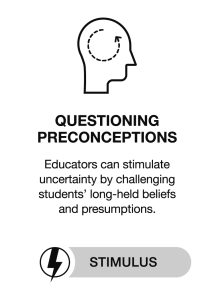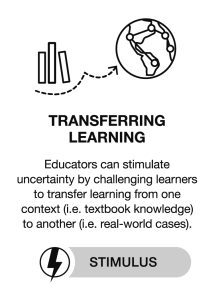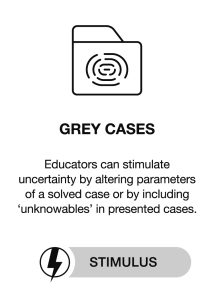Chapter 4: Purposefully Stimulating Uncertainty in Health Professions Education
Michelle D. Lazarus and Georgina C. Stephens
Learning Objectives
- Discuss the different educational activities that may be used to stimulate uncertainty for health professions learners.
- Relate educational activities that stimulate uncertainty to your own health professions context.
- Reflect on the challenges that introducing uncertainty may create in health professions education.
Health professions learners experience ‘a whole lot of uncertainty’ (Stephens et al., 2022). The findings of research with medical students suggests that uncertainties may relate to learning (e.g., what to learn and how to learn effectively), career (e.g., developing a professional identity), and clinical practice (e.g., complexity, probability, and ambiguity related to caring for patients discussed in Chapter 1) (Stephens et al., 2021; Stephens et al., 2022). Although some uncertainty stimuli are within the control of educators, some are not – for example, the complexities of placement-based or work-integrated learning can stimulate many uncertainties for learners.
With this in mind, this chapter discusses some educational uncertainty stimuli identified across the literature (Lazarus et al., 2024; Patel et al., 2022; Stephens et al., 2022), and begins to explore how these may be purposefully integrated within educational activities to allow learners to practise managing uncertainty when the stakes are (relatively) low. Critically, stimulating uncertainty should not be conceptualised as the opposite of building knowledge. Rather, uncertainty stimuli provide opportunities for educators to guide learners in constructing and applying discipline knowledge in a manner reflective of the real world with its inherent uncertainties.
Educational Uncertainty Stimuli
The authors have identified four educational uncertainty stimuli, or practical ways in which health professions educators can purposefully stimulate uncertainty, which are referred to here as questioning preconceptions, transferring learning, representing multifaceted perspectives, and engaging grey cases (Lazarus et al., 2024; Stephens et al., 2021). Each of these educational uncertainty stimuli serves to destabilise learners by challenging their perspectives and positions, forecasting uncertainty in their future careers, or placing them in unfamiliar situations and environments. This list is not exhaustive; rather, the educational uncertainty stimuli described here serve as a starting point for ideas about different approaches which educators can use to stimulate uncertainty in health professions education. Chapter 7 delves further into educational theory relevant to developing learners’ uncertainty tolerance through learning activities.
Questioning Preconceptions

Educators can stimulate uncertainty in their learners by pushing them to question their tacit knowledge, belief systems, and perceived truths (Figure 4.1). Questioning preconceptions can be led by educators (e.g., using Socratic methods) or by peers when educational activities are developed in a manner that generates debate among learners. By learners sharing and valuing different perspectives, and being given opportunities to reflect on the perspectives of themselves and their peers (see Chapter 5), they are confronted with the idea that knowledge and concepts may not be as clear-cut as they initially seem.
For example, a conceptual challenge in which learners are required to debate the role of healthcare might, along with developing understanding of evidence-based healthcare, raise the suggestion that the purpose and value of healthcare means different things to different learners, thereby introducing uncertainties related to the topic. For instance, some learners may consider healthcare’s purpose to be focused on extending life, while others might consider the role of healthcare as centred on improving quality of life, while others might consider both a primary – though not always possible in all situations.

Transferring Learning
Activities which challenge learners to apply knowledge learned in one context to another context, termed transferring learning, can stimulate uncertainty (Figure 4.2). Transferring learning draws on the concept of transfer from the education literature (Carraher & Schliemann, 2002; Dohn et al., 2020), which describes the challenges learners face when applying knowledge and skills learned in one context to another. Learners typically experience uncertainty about which aspects of prior learnings apply and about what new knowledge may also be required to navigate the novel context.
For example, medical students are often taught history and clinical examination skills related to a particular system (e.g., gastrointestinal; neurological etc.) that are typically structured in a step-wise manner. However, when these learners move to learning within the context of clinical placements they will likely observe clinicians who approach history and clinical examination in slightly different and varied ways depending on a number of factors, such as the reasons for and context of an individual’s healthcare visit, and the clinician’s experiences and preferences. In this way, the pre-clinical knowledge transfer to clinical settings introduces uncertainty.
Multifaceted Perspectives

Multifaceted perspectives can be presented through panel discussions with representatives from different groups who have an interest in the topic (Figure 4.3). When observing these panel discussions, learners can gain awareness that conflicting perspectives on priorities and values, and ambiguities in best treatment practices can coexist regarding single issues. Such discussions allow learners to build knowledge about given topics while also experiencing uncertainty.
For example, occupational therapists learning about working with people presenting with neck pain could observe a discussion between different healthcare professionals and people with lived experience of neck pain (including those who have sought differing treatments in managing the pain). The healthcare professionals might include an occupational therapist who talks about maintaining activities for people with neck pain; a neurosurgeon who talks about the potential risks, benefits, and unknowns related to surgery and recovery; a radiologist who discusses subjectivity in interpreting medical imaging; a pain researcher who describes gaps in knowledge about the mechanism of analgesic action; and a psychologist who talks about the benefits of cognitive behavioural therapy for managing physical symptoms. Multifaceted perspectives may even arise within monodisciplinary panel discussions – for example, a group of surgeons talking about their individualised techniques for managing a given pathology. In this way, uncertainty is stimulated for learners as they observe how the same topic has varied perspectives, and ambiguous knowledge.
Grey Cases

Educators can stimulate uncertainty for learners by using grey cases (Figure 4.4), which are case-based learning activities that include multiple forms of uncertainty (Lazarus et al., 2024; Stephens et al., 2021). Uncertainties within grey cases are designed to authentically represent how real-world uncertainty may arise in healthcare settings and to avoid the typecast, single-end-point approaches of some case-based learning. The key to turning traditional case-based learning into an uncertainty stimulus is to ensure that, as with real-world healthcare, not everything about the case is known and the future remains uncertain. Grey cases may be delivered across a variety of settings, including classroom-based activities, simulation, and online learning.
Uncertainty may be built into a case by limiting or omitting information provided to learners through the case scenario, providing case details that seem to conflict, or by incorporating ambiguous endpoints (e.g., allowing multiple valid answers or interpretations based on what is known about the case). Alternatively, an educator could introduce variable case progression or parameters that change when a case has been solved, asking learners how their answers would change with different preferences or demographics, or simulating changes in vital signs from those initially presented.
Uncertainty Stimuli and Curricula Design
When designing curricula intended to support health professions learners to develop skills for effectively managing uncertainty, it is important to consider where and how uncertainty stimuli arise in the learning journey, including both within and external to educator control. Uncertainty stimuli, by their very nature, can create a sense of unmooring for learners, which can often generate feelings of unease and discomfort. Depending on the individual learner and their prior experiences (alongside other moderating factors), ill-conceived or ill-timed uncertainty stimuli could create experiences that cause learners to fear and try to avoid uncertainty rather than accepting and managing it. Conversely, well-considered uncertainty stimuli that effectively support learners to develop skills for managing uncertainty can help them to accept that uncertainty is part of health professional practice and to navigate the unknown with curiosity and purpose despite the discomfort that uncertainty can provoke. Chapter 6 will describe moderators or classroom approaches which can help regulate the impacts of the educational uncertainty on learners.
Summary
Uncertainty is an inherent part of learning to become a health professional. Consideration should be given to how uncertainty can be thoughtfully stimulated in educational activities and when it is best to do this during learners’ experiences. This approach allows an educator the opportunity to plan a program that progressively increases the challenge and the educational stakes (e.g., vulnerability in the learning community, grades etc.) when managing uncertainty across a learning program. Such educational approaches may improve health professions learners’ capacity for managing uncertainty when they commence practice.
Review & Reflect
End of Chapter Review
The goal of this quiz is to check your comprehension of key terms introduced in Chapter 4.
Reflection
Reflect on how you may begin to purposefully stimulate uncertainty through your educational activities. Identify an activity within your education practice which currently doesn’t require learners to manage uncertainty. Answer the following questions regarding the activity.
- Describe the activity and the steps you take to introduce the activity to learners in its current form.
- Select an educational uncertainty stimulus discussed above which you could introduce to purposefully stimulate learner uncertainty in your context. What additional resources or supports might be required to introduce the uncertainty stimulus to the activity?
- If you were to introduce this educational uncertainty stimulus to your activity, what challenges might it create for learners?
You may find it helpful to write down or record your responses to these questions before moving on to the next chapter, which describes how moderators can influence learning activities.
References
Carraher, D., & Schliemann, A. (2002). The transfer dilemma. Journal of the Learning Sciences, 11(1), 1-24. https://doi.org/10.1207/S15327809JLS1101_1
Dohn, N. B., Markauskaite, L. & Hachmann, R. (2020). Enhancing knowledge transfer. In M. J. Bishop, E. Boling, J. Elen, & V. Svihla (Eds.), Handbook of research in educational communications and technology (5th ed., pp. 73–96). Springer Nature. https://doi.org/10.1007/978-3-030-36119-8_5
Lazarus, M. D., Gouda-Vossos, A., Ziebell, A., Parasnis, J., Mujumdar, S., & Brand, G. (2024). Mapping educational uncertainty stimuli to support health professions educators’ in developing learner uncertainty tolerance. Advances in Health Sciences Education. Advance online publication. https//doi.org/10.1007/s10459-024-10345-z
Patel, P., Hancock, J., Rogers, M., & Pollard, S. R. (2022). Improving uncertainty tolerance in medical students: A scoping review. Medical Education, 56(12), 1163–1173. https://doi.org/10.1111/medu.14873
Stephens, G. C., Rees, C. E., & Lazarus, M. D. (2021). Exploring the impact of education on preclinical medical students’ tolerance of uncertainty: A qualitative longitudinal study. Advances in Health Sciences Education, 26(1), 53–77. https://doi.org/10.1007/s10459-020-09971-0
Stephens, G. C., Sarkar, M., & Lazarus, M. D. (2022). ‘A whole lot of uncertainty’: A qualitative study exploring clinical medical students’ experiences of uncertainty stimuli. Medical Education, 56(7), 736–746. https://doi.org/10.1111/medu.14743
Media Attributions
- Figure 4.1 Card-Stimulus-Questioning-Preconceptions © Kat Orgallo is licensed under a CC BY-NC (Attribution NonCommercial) license
- Figure 4.2 Card-Stimulus-Transferring-Learning © Kat Orgallo is licensed under a CC BY-NC (Attribution NonCommercial) license
- Figure 4.3 Card-Stimulus-Multifaceted-Perspectives © Kat Orgallo is licensed under a CC BY-NC (Attribution NonCommercial) license
- Figure 4.4 Card-Stimulus-Grey-Cases © Kat Orgallo is licensed under a CC BY-NC (Attribution NonCommercial) license
Features of a phenomenon that make it challenging to grasp, caused by multiple elements interacting in a non-linear fashion. Also understood to be 'irreducible uncertainty' in sustainability literature. For more on this, refer to Chapter 3.
‘Randomness’ or ‘indeterminacy’ of future outcomes. Similar to 'aleatoric uncertainty'.
1) An experience that provokes a sense of vagueness and/or is open to multiple interpretations. 2) A property of information which stimulates uncertainty due to a lack of reliability, credibility or adequacy.
People in receipt of healthcare. This term and others such as 'client' and 'consumer' have been problematised. For instance, not all those seeking and/or engaging with healthcare identify as patients, and many think ‘clients’ illustrates a transactional relationship. We hope to be able to update this terminology to be more inclusive as the English language develops.
The reasons underlying why uncertainty may be perceived, including ambiguity, probability and complexity. Synonymous with sources of uncertainty.
Defined as educational activities which challenge tacit knowledge, belief systems and perceived truths, this type of stimulus provokes uncertainty by illustrating that knowledge and concepts may not be as clear-cut as originally perceived. For more on this term, refer to Chapter 4.
Educational activities which challenge learners to apply knowledge learned in one context to another. Transferring learning can include applying previously learned textbook or theoretical knowledge to real-world cases or transferring skills and knowledge acquired in simulation to clinical practice. When transferring knowledge from one context to another, learners face uncertainty about which aspects of prior learned knowledge apply to the new contexts and also uncertainty about what new knowledge is needed in the novel scenario. For more on this term, refer to Chapter 4.
Similar to questioning preconceptions, this method for stimulating uncertainty also challenges beliefs and tacit knowledge, but by providing multiple perspectives on the same subject. For more on this term, refer to Chapter 4.
Case-based learning activities which purposefully embed uncertainty through limiting or omitting information or by having the objective of the case focused on identifying next best steps or a differential diagnoses (as opposed to a definitive diagnosis). This type of uncertainty stimulus helps learners recognise that uncertainty is a natural part of healthcare practice. For more on this term, refer to Chapter 4.



